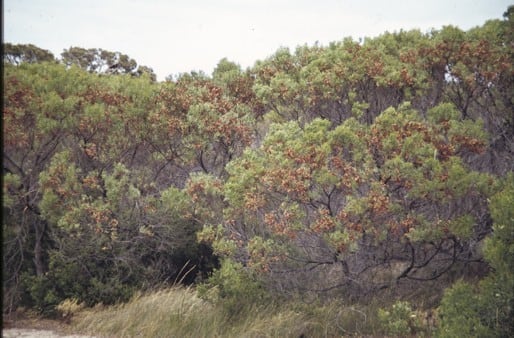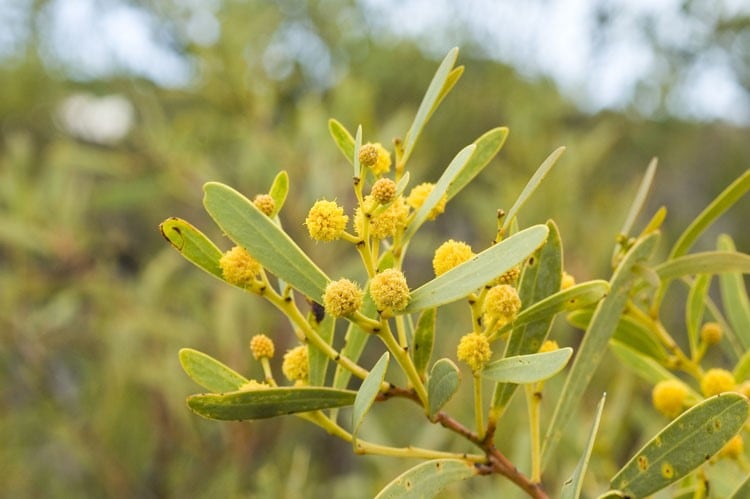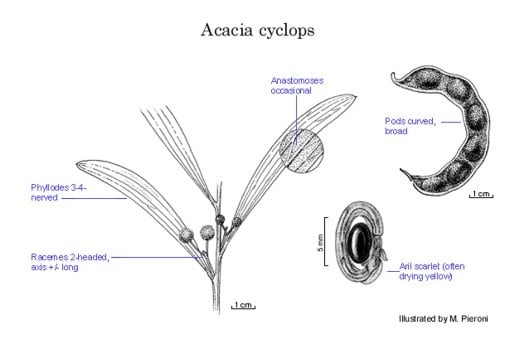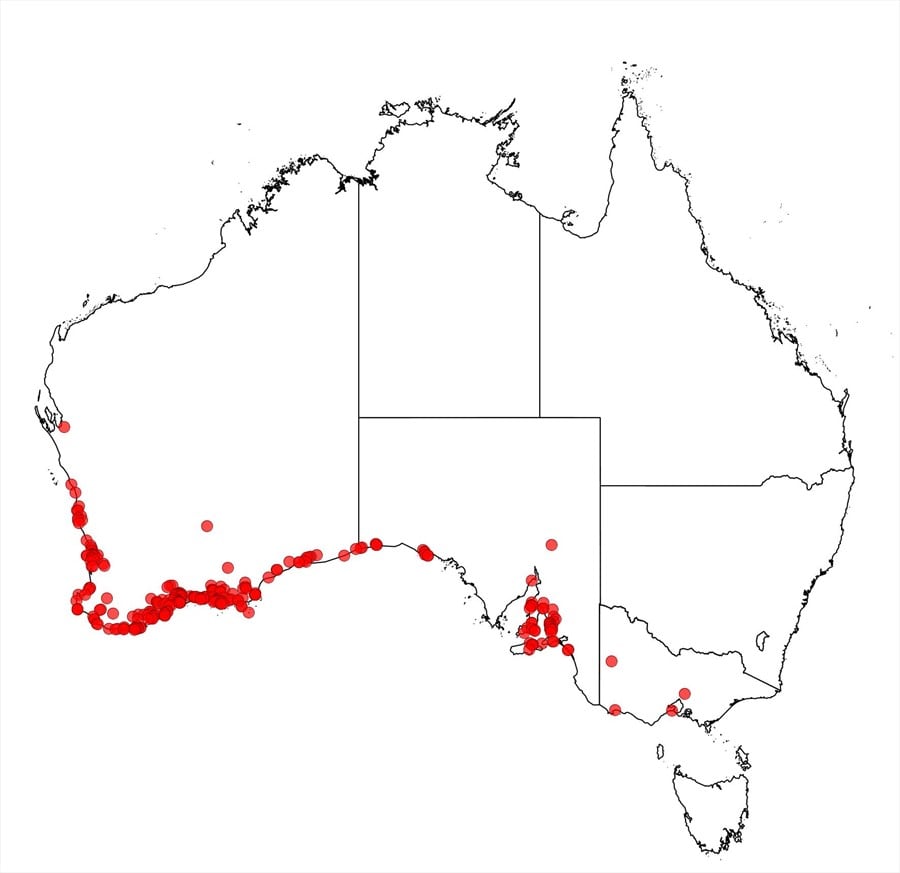Acacia cyclops A.Cunn. ex G.Don
WATTLE
Acacias of Australia
Common Name
Western Coastal Wattle, Rooikrans (South Africa)
Family
Fabaceae
Distribution
Widespread and seemingly discontinuous in coastal and near-coastal areas mainly between Denmark and Israelite Bay in south-western W.A., ranging N to Leeman in W.A. and E to near Yorketown and Yorke Penin. in S.A. A few collections E of Yorke Penin. and on Kangaroo Is., S.A., are doubtfully native. This species is incipiently adventive in SE Vic.
Description
Shrub to small tree 1–6 m high. Branchlets ±compressed apically, glabrous. Phyllodes ascending, narrowly oblong to elliptic or obovate, ±inequilateral, slightly recurved, 4–9.5 (–11) cm long, (4–) 6–15 (–22) mm wide, obtuse or acute, apiculate, coriaceous, glabrous, with 3 or 4 distant main nerves occasionally anatomosing with secondary nerves. Inflorescences 2‑headed racemes; raceme axes 3–20 mm long, somewhat compressed, glabrous or appressed-puberulous; peduncles 4–12 (–19) mm long, glabrous; heads globular, 5–7 mm diam., often 60–75-flowered, golden. Flowers 5-merous; sepals 1/2–3/4-united. Pods linear, slightly raised over seeds, arcuate before dehiscence, to 15 cm long, 7–15 mm wide, thick-coriaceous, glabrous, persistent after seed-fall. Seeds longitudinal, elliptic, 5–7 mm long, glossy, dark brown to black; funicle enlarged, encircling seed in two folds, orange to scarlet.
Habitat
Grows mainly in coastal heath or scrubland in loam or sand (often over limestone).
Specimens
W.A.: 19.5 km SE of Mundrabilla HS, B.Downing 848 (MEL, PERTH); 8 km S of Ravensthorpe on road to Hopetoun, B.R.Maslin 808 (B, K, L, PERTH); Bremer Bay, P.G.Wilson 4304 (MEL, NSW, PERTH). S.A.: c. 1 km N of Moonta on road to Kadina, B.R.Maslin 4542 (PERTH). Vic.: 2 km ENE of Surrey R., B.C.Beecham 8 (MEL).
Notes
Acacia cyclops is as drought-tolerant as A. saligna, and is more tolerant to sea spray. It is tolerant of highly saline soils, fide N.Marcar et al., Trees for Saltland 30 (1995). A. cyclops is grown mainly to stabilise coastal sand dunes notably in north Africa; although its fodder value is inferior to that of A. saligna it produces a dense, high quality fuelwood, fide M.H.El-Lakany, in J.W.Turnbull (ed.), Australian Acacias in Developing Countries 116–117 (1987). Like A. saligna, this species is a major environmental weed in South Africa, fide C.H.Stirton, Plant Invaders 40–43 (1978). Further information on the biological and ecological features, and the utilisation potential, of this species is given in B.R.Maslin and M.W.McDonald, AcaciaSearch: Evaluation of Acacia as a woody crop option for southern Australia, RIRDC Publication No. 03/017, 54–58 (2004).
A proposal by B.R.Maslin & P.G.Wilson, Taxon 56: 288 (2007) to conserve the name A. cyclops over A. eglandulosa was recommended for approval, see R.K. Brummitt, Taxon 58: 288 (2009) and is now listed in the Code.
Perhaps related to A. redolens but strikingly different from otherwise similar species by its colourful aril surrounding the seed. Flowers and mature fruit are often found together on the one plant, further distinguishing the species. Also similar to A. veronica.
FOA Reference
Data derived from Flora of Australia Volumes 11A (2001), 11B (2001) and 12 (1998), products of ABRS, ©Commonwealth of Australia
Author
Minor edits by B.R.Maslin & J.Rogers
R.S.Cowan, B.R.Maslin
This identification key and fact sheets are available as a mobile application:
URL: https://apps.lucidcentral.org/wattle/
© Copyright 2018. All rights reserved.














